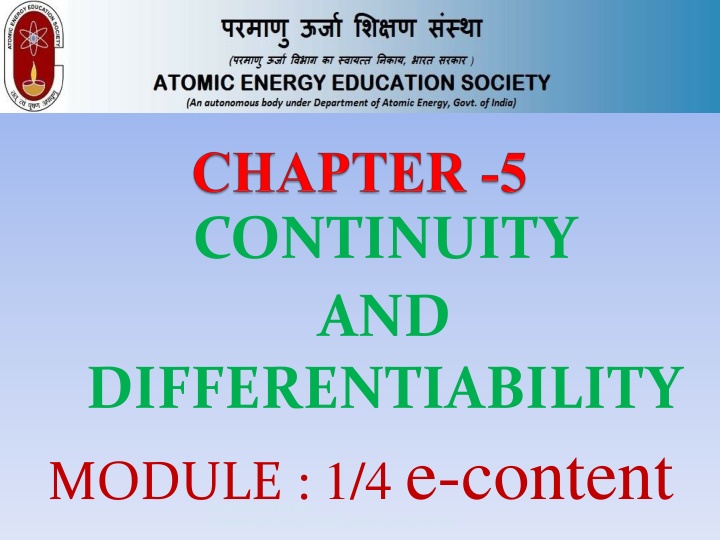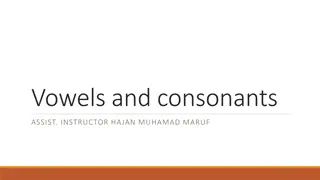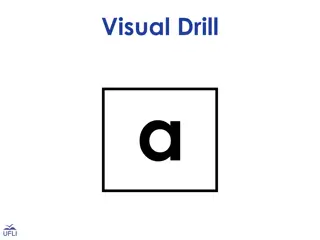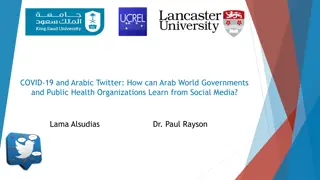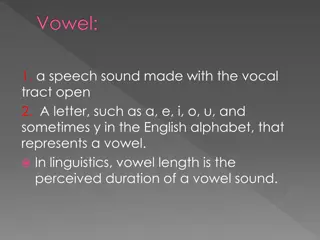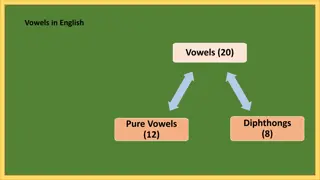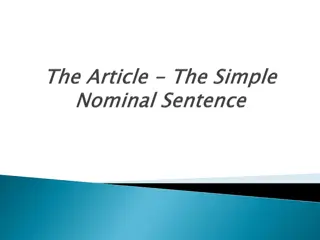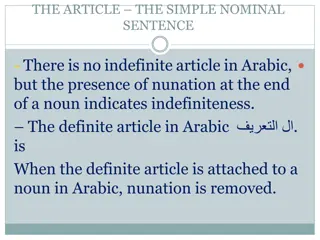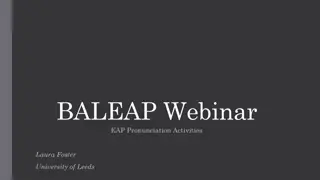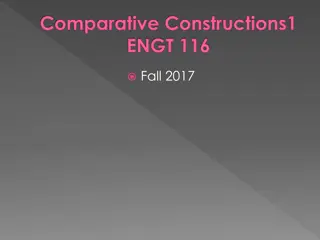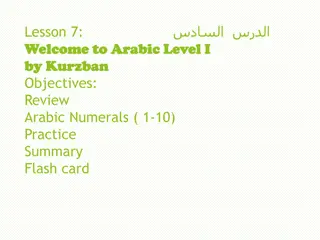Arabic Vowels and Diphthongs
Explore the intricacies of Arabic vowels, diphthongs, nunation, stress, abbreviations, and the alphabet represented as numbers. Discover the different vowel sounds, learn about short and long syllables, understand diphthongs, and grasp the concept of nunation. Enhance your knowledge of Arabic linguistics with visual aids and explanations.
Download Presentation

Please find below an Image/Link to download the presentation.
The content on the website is provided AS IS for your information and personal use only. It may not be sold, licensed, or shared on other websites without obtaining consent from the author.If you encounter any issues during the download, it is possible that the publisher has removed the file from their server.
You are allowed to download the files provided on this website for personal or commercial use, subject to the condition that they are used lawfully. All files are the property of their respective owners.
The content on the website is provided AS IS for your information and personal use only. It may not be sold, licensed, or shared on other websites without obtaining consent from the author.
E N D
Presentation Transcript
CONTINUITY AND DIFFERENTIABILITY MODULE : 1/4 e-content MADHUSUDANAN NAMBOODIRI.V,PGT(SS),AECS-1,JADUGUDA
PREVIOUS KNOWLEDGE Graph of various functions Concept of limit Evaluation of limit of certain functions Definition of derivative and differentiation of certain functions Product rule and Quotient rule of differentiation MADHUSUDANAN NAMBOODIRI.V,PGT(SS),AECS-1,JADUGUDA
Consider the function f(x) = [ x] . Let us find the limiting value of f(x) when x approaches to 2. x 2 from both 2 from both sides of 2 sides of 2 Fig -1 MADHUSUDANAN NAMBOODIRI.V,PGT(SS),AECS-1,JADUGUDA
From the figure we can see that when x approaches to 2 from left of 2 (green arrow in the fig-1 ) the limiting value of f(x) is one and as x approaches to 2 from right of 2 (violet arrow in the fig-1 ) the limiting value of f(x) is 2.The value of the function at x = 2 is 2. ie lim? 2 ? ? = 1 and lim? 2+? ? = 2 ??? ? 2 = 2. If all these values are same then we say that the function f(x) is continuous at x = 2. In this case there is no break in the graph. Definition: Suppose f is a real function on a subset of the real numbers and let c be a point in the domain of f. Then f is continuous at c if lim ? ?? ? = ?(?) MADHUSUDANAN NAMBOODIRI.V,PGT(SS),AECS-1,JADUGUDA
If f(x) is continuous at x = c then lim Or L.H.L = R.H.L = Value of the function at that point ? ?+? ? = ?(?) ? ? ? ? = lim If f is not continuous at c then we say f is discontinuous at c and c is called a point of discontinuity of f. Examples: Discuss the continuity of the function f given by f(x) = | x | at x = 0 We know that f(x) = ? = ? ? ?? ? < 0 The function is defined at x = 0 and f(0) = 0 Left hand limit of f at x = 0 is lim? 0 ? ? = 0 and the right hand limit of the function at x = 0 is lim? 0+? ? = 0 (fig-2) The left hand limit, right hand limit and the value of the function coincide at x = 0. Hence, f is continuous at x = 0 MADHUSUDANAN NAMBOODIRI.V,PGT(SS),AECS-1,JADUGUDA ?? ? 0
Note : There is no break in the graph x 0 from both sides Fig-2 A real function f is said to be continuous if it is continuous at every point in the domain of f MADHUSUDANAN NAMBOODIRI.V,PGT(SS),AECS-1,JADUGUDA
CONTINUITY IN AN INTERVAL A function f(x) is said to be continuous in an open interval (a ,b ) if it is continuous at every point in that interval and in [a ,b]if it is continuous in (a,b) and lim? ?+? ? = ?(?) and lim? ? ? ? = ?(?) We cannot find the left limit at x = a and the right limit at x = b Example: Let us check the continuity of the function f(x) = | x | at x = c We know that f(x) = ? = ? ?? ? 0 ? ?? ? < 0 We consider two cases MADHUSUDANAN NAMBOODIRI.V,PGT(SS),AECS-1,JADUGUDA
. Case : 1 When c < 0 Clearly the function is defined at x = c and f(c) = - c if c < 0. Also lim? ?? ? = ? f(x) is continuous for all c where c < 0 ie for all negative real numbers Case : 2 When c > 0 Clearly the function is defined at x = c and f(c) = c if c > 0. Also lim? ?? ? = ? f(x) is continuous for all c where c > 0 ie for all positive real numbers Hence f(x) = | x | is continuous at all points MADHUSUDANAN NAMBOODIRI.V,PGT(SS),AECS-1,JADUGUDA
Example: Consider the function f(x) = 1 ?, x 0 For any non zero real number c, f(c) = 1 ? and lim? ?? ? =1 ? Hence the function is continuous at all non zero real numbers. Let us check the limit of this function as x 0 Fig-3 MADHUSUDANAN NAMBOODIRI.V,PGT(SS),AECS-1,JADUGUDA
As x 0 from right from the table we get lim?0+? ? = + As x 0 from left from the table we get lim? 0 ? ? = Hence limit of f(x) does not exist as x 0 (fig-3) ( Note break in the graph) MADHUSUDANAN NAMBOODIRI.V,PGT(SS),AECS-1,JADUGUDA
Examples of some functions which are continuous 1. Every polynomial function is continuous 2. All trigonometric functions are continuous in their domain 3. Greatest integer function is continuous at all non integral points but discontinuous at every integral point 4. Constant function is continuous 5. Identity function is continuous 6. Every rational function is continuous at all point were the function is defined MADHUSUDANAN NAMBOODIRI.V,PGT(SS),AECS-1,JADUGUDA
Algebra of continuous functions If f and g be two real functions continuous at c. Then (1) f + g is continuous at x = c. (2) f g is continuous at x = c. (3) f . g is continuous at x = c. (4) f/g is continuous at x = c provided g( c ) 0 Examples: Q1.Find the value of k so that the function 1 ???4? 8?2 ? ,?? ? = 0 ,?? ? 0 is continuous at x = 0 f(x) = Solution: MADHUSUDANAN NAMBOODIRI.V,PGT(SS),AECS-1,JADUGUDA
Given f(x) = 1 ???4? 8?2 ? ,?? ? = 0 ,?? ? 0 Since f(x) is continuous at x = 0 lim? 0 ? ? = lim? 0+? ? = ?(0) ------(1) Given f(x) = 1 ???4? 8?2 lim? 0 ? ? = lim? 0 ( put x = 0-h, x = -h, as x 0, h 0 ) 2???22 8 2 = lim 0 4 2 Here f(0) = k From equation (1) , k = 1 ,?? ? 0. 1 ???4? 8?2 1 cos( 4 ) 8 2 = lim 0 2 ???22 ???2 2 = lim 0 = lim 0 = 1 MADHUSUDANAN NAMBOODIRI.V,PGT(SS),AECS-1,JADUGUDA
1???4? ?2 ? ,?? ? = 0 ,?? ? < 0 Q2.If f(x) = is continuous at x = 0 ? 16+ ? 4 ,?? ? > 0 then find the value of a. Solution: Given f(x) is continuous at x =0.Hence lim? 0 ? ? = lim? 0+? ? = ?(0)---------(1) 1 ???4? 1 ???4 2 lim? 0 ? ? = lim = lim 0 2 = ?2 ? 0 2 2 ???22 2 ???2 2 ???2 2 = lim 02 4 = 8 lim lim 0 0 ???? ? ? ? = 8 MADHUSUDANAN NAMBOODIRI.V,PGT(SS),AECS-1,JADUGUDA
? lim? 0+? ? = lim ? 0+ 16 + ? 4 16+ +4 16+ +4 16+ +4 =lim = lim 0 16+ 4 16+ 16 0 16+ +4 = lim 0 ??? ? ?+?(?) = ? f(0) = a From equation (1) lim? 0 ? ? = lim? 0+? ? = ?(0) a = 8 = 16 + 4 = 8 MADHUSUDANAN NAMBOODIRI.V,PGT(SS),AECS-1,JADUGUDA
Q3.If the function f(x) given by 3?? + ? ,?? ? > 1 11 ,?? ? = 1 5?? 2? ,?? ? < 1 ? ? = is continuous at x = 1 , then find the values of a and b Solution: 3?? + ? ,?? ? > 1 11 ,?? ? = 1 5?? 2? ,?? ? < 1 The given function is ? ? = Given that it is continuous at x = 1. (LHL)at x =1 =(RHL)at x = 1 = f(1) --------(1) MADHUSUDANAN NAMBOODIRI.V,PGT(SS),AECS-1,JADUGUDA
LHL = lim ? 1 ? ? = lim = lim ? 1 5?? 2? 05? 1 2? = 5a - 2b (put x = 1-h , as x 1,h 0) RHL = lim ? 1+? ? = lim =lim ? 1+3?? + ? 03? 1 + + ? = 3a + b (put x = 1+h , as x 1,h 0) Given f(1) = 11. From equation (1) LHL = f(1) 5a 2b = 11 --------(2) RHL = f(1) 3a + b = 11 -----------(3) Solving equation (2) and (3) we get a = 3, b = 2 Hence a = 3, b = 2 MADHUSUDANAN NAMBOODIRI.V,PGT(SS),AECS-1,JADUGUDA
SUMMARY A function f(x) is continuous at x = a , LHL = RHL = f(a) where LHL = lim ? ? ?(?) , RHL = lim ? ?+?(?) A function y = f(x) is said to be continuous in an interval ( a , b) if it is continuous at every point in that interval Suppose f and g are two real functions continuous at x = a, a real number then 1) f + g is continuous at x = a 2) f g is continuous a x= a 4)? 3) f.g is continuous at x = a ? is continuous at x = a 5) kf is continuous at x = a, where k is a constant MADHUSUDANAN NAMBOODIRI.V,PGT(SS),AECS-1,JADUGUDA
QUESTIONS FOR PRACTICE Q1.Find the value of a for which the function f defined ? 2(? + 1) ,? 0 ???? ???? ?3 ? ??? by ? ? = is ,? > 0 Continuous at x = 0 Q2.Examin the continuity of the following function: ? 2 ? ,? 0 1 2 ,? = 0 f(x) = at x = 0 MADHUSUDANAN NAMBOODIRI.V,PGT(SS),AECS-1,JADUGUDA
